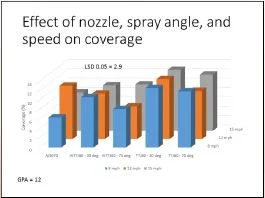Research Report: Management Fusarium head blight (scab) of wheat and barley with foliar fungicides
By Carl Bradley, University of Kentucky Extension Entomology Specialist
Full Report (PDF)
Research trials funded by the Kentucky Small Grain Growers Association were conducted on soft red winter wheat and winter barley during the 2016-17 growing season at the University of Kentucky Research & Education Center in Princeton, KY. The overall objective of the research trials were to develop the best recommendations for managing Fusarium head blight (FHB; also known as scab) and the associated mycotoxin deoxynivalenol (DON; also known as vomitoxin) with foliar fungicides. The specific objective of each trial differed, and details and results of these trials are provided below.
PLEASE NOTE THAT SOME OF THE TREATMENTS EVALUATED ARE FOR RESEARCH PURPOSES ONLY AND MAY NOT BE REGISTERED FOR USE OR MAY HAVE BEEN AN APPLICATION THAT IS NOT IN ACCORDANCE WITH THE LABEL. ALWAYS READ AND FOLLOW LABEL DIRECTIONS AND REGULATIONS BEFORE MAKING A FUNGICIDE APPLICATION.
Soft red winter wheat fungicide trial
The objective of the soft red winter wheat trial was to determine if sequential applications of fungicides would provide better control of FHB and DON compared to a single application of a foliar fungicide. The treatments consisted of the fungicides Prosaro (applied at 6.5 fl oz/acre), Caramba (applied at 13.5 fl oz/acre), Folicur (applied at 4 fl oz/acre), or Miravis Ace (applied at 13.7 fl oz/acre) applied at Feekes growth stage 10.5.1 (beginning flowering) or sequential applications of Prosaro (Feekes 10.5.1) followed by Folicur (4 days later), Caramba (Feekes 10.5.1) followed by Folicur (4 days later), Folicur (Feekes 10.5.1) followed by Folicur (4 days later), or Miravis Ace (Feekes 10.5.1) followed by Folicur (4 days later). A nontreated check also was included as a treatment. Each treatment was replicated 4 times, and a mist-irrigation system was used to help provide an environment that would be favorable for FHB. The FHBsusceptible variety Agripro W1566 was used for this trial.
No statistically significant differences among treatments were observed for FHB index. Although not significantly different than the untreated check, FHB index values were lower when any of the single or sequential fungicide applications were made. No statistically significant differences among treatments were observed for DON concentrations in harvested grain. Although not statistically different from other treatments, the lowest DON concentration was observed in grain harvested from plots treated with a sequential application of Miravis Ace followed by Folicur.
Conclusions. Fusarium head blight and DON levels were too low in this trial to show statistically significant differences among the treatments. An additional year of the research is being planned.
Winter barley fungicide trial
The objective of the winter barley trial was to determine the best growth stage to apply a foliar fungicide to achieve the best control of FHB and DON. Prosaro (6.5 fl oz/acre), Caramba (13.5 fl oz/acre), Folicur (4 fl oz/acre), or Miravis Ace (13.7 fl oz/acre) was applied at either the boot stage, heading stage, or 5 days after heading. A nontreated check also was included as a treatment. Each treatment was replicated 4 times, and a mistirrigation system was used to help provide an environment that would be favorable for FHB. The FHB-susceptible variety Thoroughbred was used for this trial.
The only treatment that had a statistically significant lower DON value than the untreated check was Miravis Ace applied 5 days after heading.
Conclusions. Although DON levels were relatively low in this trial, a statistically significant reduction in DON was observed with the Miravis Ace treatment applied 5 days after heading. However, to draw firm conclusions, it is important that this trial be repeated to ensure that the effects of the treatments evaluated are consistent. This research trial will be repeated again in 2018.
Fungicide coverage in soft red winter wheat
The objective of this trial was to evaluate the coverage of the wheat head with different fungicide application systems. Three different nozzle tips and orientations were evaluated at three different speeds. To evaluate coverage of the wheat head, water sensitive paper cards were wrapped around test tubes that were the approximate same size in diameter as wheat heads, placed on a metal rod at the approximate height of wheat heads, and water was applied through the different application systems. The research trial was conducted in a wheat field. Water sensitive cards were collected after water applications, digitally scanned, and special software was used to determine the % coverage of the cards with water droplets.
As observed in the figure below, statistically significant differences in coverage occurred among the different application systems evaluated. The greatest coverage occurred with the TurboTeejet 60 nozzles at a 30 degree angle at a speed of 15 mph.
Conclusions. The potential treatment variables that could be evaluated in a trial like this are endless (i.e. nozzle tip, nozzle orientation, height, speed, pressure, etc.). The treatments evaluated in this study were agreed upon for an initial investigation into these potential variables. Additional research will be conducted next year. One interesting observation is that the greatest % coverage was just above 12%. It is likely that fungicide efficacy on Fusarium head blight control will increase as head coverage increases, and much work is needed to develop fungicide application systems that will deliver a high amount (greater than 50%) of coverage.
See all tables and figures from this research at www.kysmallgrains.org.

